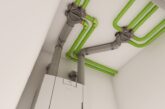
James Mills of Rockwool outlines the best practice for effective sound insulation.
How is sound measured?
Sound is measured in decibels using a logarithmic scale of intensity organised from low to high. As can be seen from the image, a normal conversation registers at approximately 50 dB, a noisy restaurant at 85 dB, and a jet taking off at 130 dB! As a rule of thumb, sounds above 85dB can be harmful, dependent on how long and how often there is exposure to them and whether ear protection is being worn.
How does sound travel?
Sound travels through the air in ‘sound waves’ as well as through solid objects which causes them to vibrate. In the context of the building trade, we classify sound into two types; airborne sound, an example would be a conversation we are overhearing, and the impact sound, which is produced by two elements coming into contact, such as when we can hear someone using a hammer to knock in a nail. Both types of sound (airborne and impact) can be reduced with a well thought through sound insulation solution that uses the right type of product.
How does insulation work?
Insulation works through acoustical sound absorption. That means it has the ability to absorb rather than reflect sound. Rockwool products can help reduce sound between rooms as well as noise from the exterior environment. Also depending on the application, the acoustic properties of the building materials and fixtures and fittings you choose will play a significant role in overall soundproofing and noise reduction.
When dealing with noise, tackling the routes through which it can enter a room is important. Windows, doors, walls, and floors are the key areas to focus on and getting the details right is essential.
- Windows
Double or triple glazed windows can help to significantly reduce external noise sources such as those from road, rail, and air. Fitting windows using an insulated DPC, such as ROCKCLOSE, will not only improve the acoustic performance, but also add fire resistance and reduce thermal bridging. While adding extra glazing layers is beneficial it is also vital to ensure there are no gaps or holes in the sealant around the frame. The window system is only as good as its weakest point. By using an acoustic sealant, such as the Firestop Acoustic Intumescent Sealant, it is possible to further enhance the effectiveness of double or triple-glazed windows and ensure maximum return on investment for your customer.
- Doors
Solid wood doors have a density and mass that helps block out unwanted noise. For specialist applications, such as a home studio, sound-proofed internal doors, with a sound insulation core, are available. Once again, make sure the details are considered: pay close attention to the fit of the door and consider using draft excluders to maximise the acoustic performance, even for internal doors, where appropriate.
- Walls
Preventing noise transfer from room to room within a house is vital if effective acoustic control is to be achieved. To enhance the noise reduction of a framed partition wall there are several things that can be done. You could use acoustic-rated plasterboard, but this can be expensive. Another approach would be to insulate the wall frame behind the plasterboard. This is a highly efficient and cost-effective way to reduce noise transfer. Rockwool Sound Slab adds mass to a wall and the non-directional fibre orientation means that it is highly effective at trapping and absorbing airborne sound waves. Also, one (or both sides) of the plasterboard can be decoupled using a resilient bar. This has the effect of preventing vibration, or impact- based noise from transferring through the structure. Again, select an acoustic sealant that seals weak spots which could compromise hard work and investment.
- Floors
Sound wave vibrations are surprisingly efficient in travelling through solid structure and in homes with hard floors, particularly apartments, impact noise caused by footsteps can be a challenging problem to deal with. There are two key elements to consider in trying to resolve this issue. The first (as with walls) is to use a resilient layer to decouple the plasterboard from the floor joists. This breaks the chain of continuous structure and stops the vibration noise in its tracks. Another effective method is to add a layer of Acoustic ROCKFLOOR, which offers immensely robust impact sound protection. When laid at a thickness of over 20mm it is especially effective at reducing the hard to combat, impact noise generated by footsteps coming through the floor from above. When combined with Sound Slab between joists, decoupling of the ceiling plasterboard, the product can solve problems that leave many scratching their heads.
For more information on sound insulation solutions from Rockwool visit https://www.rockwool.co.uk/







